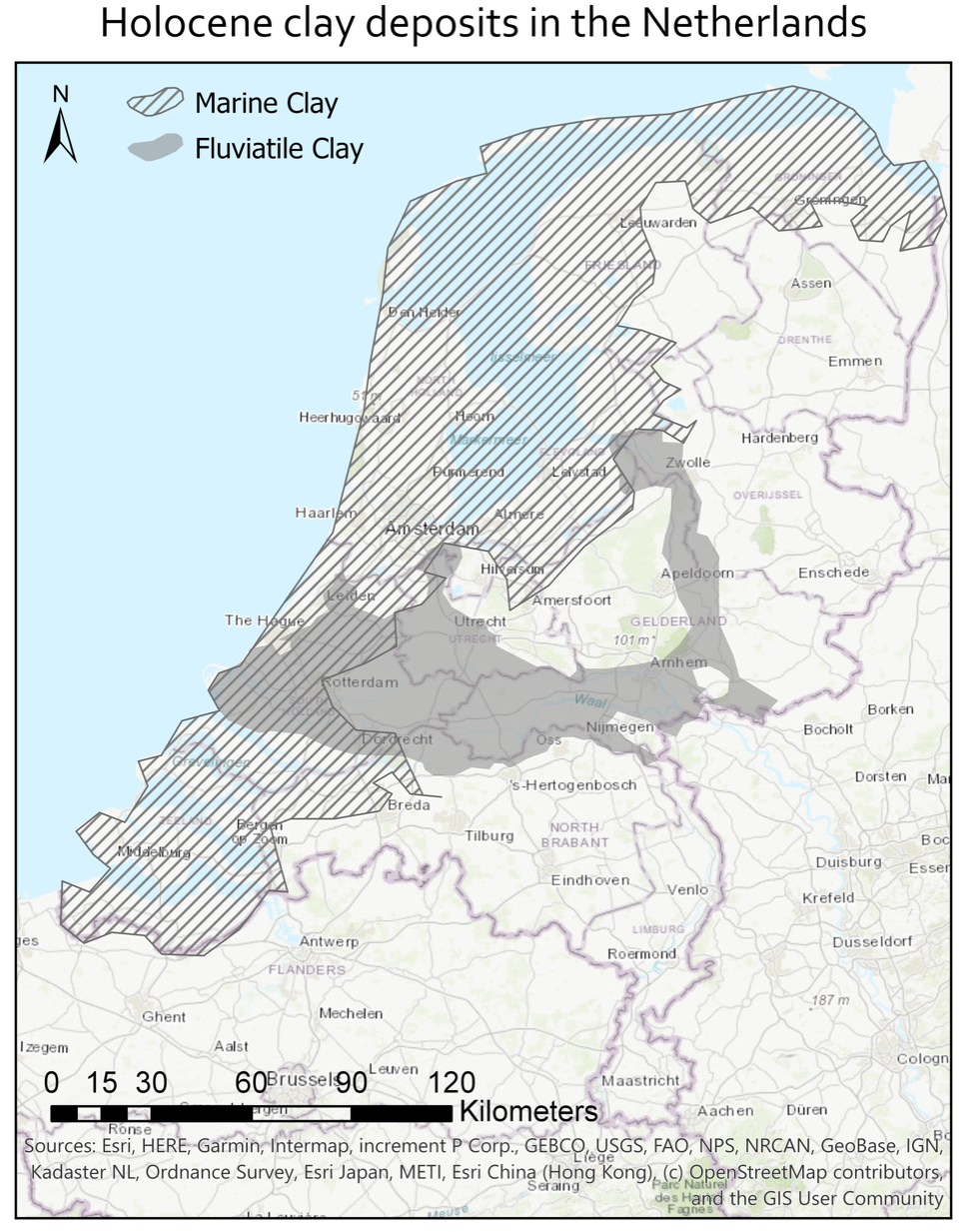WP2.4 – Physical and chemical processes in soil subsidence and swelling in clays
Introduction
A large part of the low-lying areas in the Netherlands is rich in Holocene clay deposits (next to organic deposits and peat). These young clays are relatively easily deformed, compared to older deposits that are often buried deeper. During additional loading, the change in effective stress causes the void space to decline. The void space can also decrease due to increased soil suction, which is induced by evaporation or declining groundwater levels, causing shrinkage (and physical ripening) of the clay deposits. This process is partly reversible, but if a soil suction threshold is exceeded, (part) of the shrinkage is irreversible. Irreversible shrinkage due to drying in shallow deposits is also described as physical ripening of the soil.

Sample locations Montfoort (M) and Abbenes (A) and an indication of the marine and fluviatile Holocene clay deposits in the Netherlands.
In combination with the physical volume change processes, also chemical change of the pore water composition can change the structure and thus volume of the clay deposits. Irreversible volume loss of clay deposits yields land subsidence. As the clay deposits are mostly situated in the low-lying areas of the Netherlands, their permanent compaction would increase the intensity and risk of floods and saltwater intrusion. The reversible volume change has already caused a significant amount of damage to infrastructure and building. Especially during the recent dry summers, indicating the importance of predicting clay shrinkage around infrastructure and in urban areas.
The focus of this project is to determine the governing soil characteristics with respect to swelling-shrinkage behaviour of clay deposits and quantify the irreversible and reversible shrinkage taking place in the deposits in relation to different physio-chemical conditions. The goal is to determine an empirical relationship between shrinkage behaviour and governing factors. The results will enable us to predict soil shrinkage-swelling behaviour and identify risk factors in relation to volume change in clay deposits.
Approaching soil shrinkage
To assess shrinkage behaviour soil shrinkage curves are constructed. These curves relate moisture content and void ratio and have been intensively studied using remoulded, synthetic or small samples. The shrinkage curve has been correlated with soil characteristics such as expansive clay content (Crescimanno & Provenzano, 1999; Mishra et al., 2008), organic matter content (Peng & Horn, 2007; ), soil density, specific surface area, cation exchange capacity (Gray & Allbrook, 2002) and maximum adsorbed water content (Lu & Dong, 2015).
These characteristics can be related to the soil water retention curve (SWRC, or pF-curve), which related the water content to the soil water suction. Greene-Kelly (1974) also found a significant correlation between expansive mineral content and shrinkage for remoulded samples, but not for samples that have been exposed to drying and wetting cycles, indicating the effect of stress history on the shrinkage behaviour. Rasa et al. (2009) studied the effect of land use on shrinkage and found a difference of 4.8% in total shrinkage when a clay soil was managed differently, whereas on average shrinkage was 10% in these soils. These results highlight the importance of studying natural undisturbed samples to identify shrinkage governing soil characteristics.
A soil shrinkage curve thus yields a very detailed overview of the shrinkage over time and can be coupled to soil characteristics. For these reasons we have decided to use the soil-shrinkage curve as an important tool to describe shrinkage of clay deposits.
Project set-up
During this project we have designed a new automated measurement set-up to measure shrinkage of samples extracted from clay deposits, for several samples simultaneously. The data gathered will be converted to soil shrinkage curves with accompanying pF-curves. The newly developed method enables us to measure shrinkage of natural samples with minimal disturbance before and during measurements. We use a specially designed sample extraction material and measure the dimensions of the samples with optical distance sensors as to not influence the evaporation. The development of the method is completed and now in use.
Directly after testing we have set-up an experiment to determine the influence of increased porewater salinity on shrinkage behaviour of Holocene fluviatile clay from the Netherlands. We are currently analyzing the data and writing down the findings: there is a significant influence of specific saline solutions on shrinkage behaviour of these samples and the salinity affects the distribution between irreversible and reversible shrinkage). The preliminary findings were presented at the last LOSS Symposium (November 2022).
The planned next step is to measure shrinkage of samples collected at land movement/subsidence monitoring sites in the Netherlands to study the agreement between the lab set-up and measured vertical movement in the field at different locations and depths. We expect to have results at the end of Summer 2023. Alongside the aforementioned sub-project, we are working on using the gathered data directly into the shallow subsurface modelling carried out by Tom de Gast.
Contact
The PhD candidate working on WP2.4 is Bente Lexmond (Utrecht University, Physical Geography), supervised by Esther Stouthamer (UU), Jasper Griffioen (TNO,UU) and Gilles Erkens (Deltares, UU). The research started October 2020. For more information on this research, please contact Bente Lexmond at b.r.lexmond@uu.nl.
References
Crescimanno, G., & Provenzano, G. (1999). Soil shrinkage characteristic curve in clay soils: Measurement and prediction. Soil Science Society of America Journal, 63(1), 25-32.
Gray, C. W., & Allbrook, R. (2002). Relationships between shrinkage indices and soil properties in some New Zealand soils. Geoderma, 108(3-4), 287-299.
Greene-Kelly, R. (1974). Shrinkage of clay soils: A statistical correlation with other soil properties. Geoderma, 11(4), 243-257.
Lu, N., & Dong, Y. (2017). Correlation between soil-shrinkage curve and water-retention characteristics. J. Geotech. Geoenviron. Eng, 143(9), 04017054.
Peng, X., Horn, R., & Smucker, A. (2007). Pore shrinkage dependency of inorganic and organic soils on wetting and drying cycles. Soil Science Society of America Journal, 71(4), 1095-1104.
Rasa, K., Horn, R., Räty, M., Yli‐Halla, M., & Pietola, L. (2009). Shrinkage properties of differently managed clay soils in Finland. Soil use and management, 25(2), 175-182.

